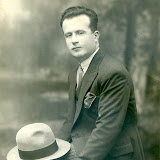Studio portraits from the 1920s and 1930s
The dumb brown eyes held hers. His voice was low, gentle. The sense of pleasure came upon her just as it had done in the shop the day before. He pressed the bulb. There was a little clicking sound.
Daphne du Maurier; The Little Photographer
Daphne du Maurier’s little photographer, Monsieur Paul, is an innocuous man. He lives in a shabby cottage in a small French village and gets by with no apparent talents. He is dour and unassuming. He also has a limp. The bored marquise who toys with him finds his manner of fussing over his equipment mildly interesting. Too bad for her she doesn’t show his attention to detail, but that is beside the point. He is typical of the few photographers who turn up in mid 20th century literature. They tend to be men of mediocre habits and appearance though they can also be voyeurs and obsessives who retreat to their darkrooms to vent their peculiar fixations. They don’t seek clients so much as prey on them. Even with M. Paul, there is a vaguely creepy about him that suggests he isn’t entirely an innocent victim.
Whatever attention studio photographers received in the first half of the 20th century was seldom positive. No one seriously thought of them as artists; it was hard to when most of them were processing their clients on a virtual conveyor belt, moving them from the waiting room to the studio to the cashier (assuming the business was that sophisticated) by which time the sitter had become a mere number in a register. Nor was photography a craft in the traditional use of the term, which suggested patient and skilled manual work. Du Maurier’s little photographer tells the marquise that he goes out into the countryside to take photos he can sell as postcards. He makes it sound like such an inconsequential way to make a living and a lot of people probably thought photography was an easy occupation. What else did you need but a camera, some lights and a workspace? The customers didn’t care whether the photographer was an artist or not, they just wanted to look good.
We don’t have to care either. That an image looks strange or beautiful doesn’t necessarily qualify it as art. Still, there is something about the images in this post that lifts them above the commonplace. Photographing people against a studio backdrop was supposed to do that. It didn’t matter that a dozen or more customers had already posed in front of the same scene already that day; the backdrop suggested there was something unique about the sitter.
The backdrops and props rarely varied between studios. They were forest scenes and classical landscapes. Cheap plaster columns and balustrades implied a connection to antiquity or wealthy sophistication, seashores and woodland streams an Arcadian spirit. No one was fooled but no one was meant to be. The idea was to take an ordinary person and make them appear special. Maybe that’s why the best subjects were from the very middle class. These are portraits of people whose lives revolved around office jobs and regular hours and didn’t have much time for fantasy to enter their lives.
Most of the photographers remain completely anonymous but they must have had some kind of empathy with their sitters to know what it was that they’d want and how to make them look how they wanted to. Maybe that’s one reason why they got such bad write=ups from literary authors. People like Daphne du Maurier must have been privately disappointed by the banality of studio photography so invested the operators with sinister leanings. Perhaps she was affronted by images like these that on the surface had the appearance of art yet seemed to be in contempt of it.
 |
| STUDIO PORTRAITS |





No comments:
Post a Comment
Add comments here